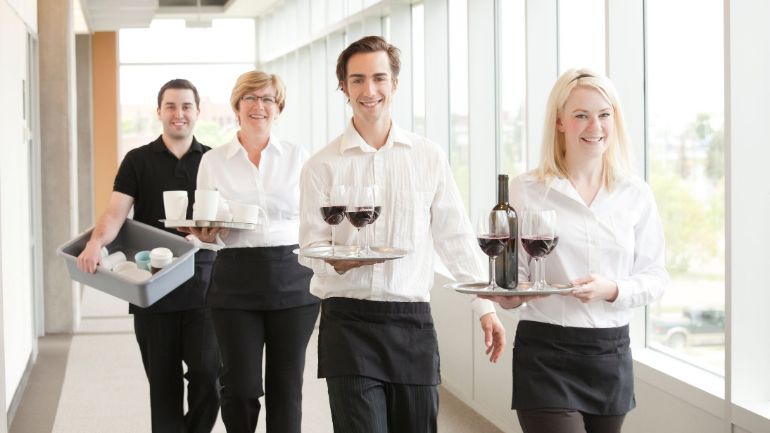Your restaurant is doing well. Sales are up, profits are pretty decent, and you’re seeing the same loyal customers returning week after week.
But you want more. So where do you turn to get more customers?
Answer: Restaurant catering.
The Bureau of Labor Statistics estimates that the average household spends $3,000 annually on restaurants (a 94% increase since 2003). With that many people already eating out, and a growing number of restaurants competing for their attention, more and more restaurant owners are turning to restaurant catering as a means of reaching a wider customer base.
However, creating a catering business plan from scratch or incorporating a catering element into your existing business is no small feat, which is why we’ve decided to break the whole thing down into canapé-sized bites for you.

Use this banquet event order template to streamline your catering operations and exceed client expectations.
As always, we’re here to offer resources and support to nudge you toward success. Below, we’ve broken our recipe for a winning restaurant catering business into five digestible parts:
- On- vs. off-premise catering
- Restaurant catering menu ideas
- Setting menu prices
- How your POS can help
- Marketing your catering business
Before we start, let’s take a moment to go over the pros and cons of adding a catering element to your existing business.
Pros of Restaurant Catering
- As a restaurant owner, you have an existing customer base to tap into as you launch your business.
- Brand awareness is already in place, making it easier to market the addition than starting from scratch.
- Every event you cater is an opportunity to reach new customers that you aren’t currently targeting with marketing or advertising efforts.

Make your catering business a reality with this customizable catering business plan template.
Cons of Restaurant Catering
- Incorporating a catering element into your existing business can feel like opening a second business because it’s time consuming.
- You’re building an extension of your existing business, which will reflect on your existing brand. You’ll need to identify someone you trust to lead the charge.
- Providing a quality catering service requires a lot of organization and time management, so you’ll need to invest in the financial and personnel resources to get it off the ground and keep it running.
Still curious? Let’s keep moving.

Here are some key restaurant catering ideas to explore as you set up your business.
On vs. Off Premise Catering
The difference between on- and off-premise catering is rather self-explanatory.
On-premise catering takes place in your restaurant while off-premise catering involves you bringing the food to the customer. Both come with some major considerations, which we’ve outlined below.
- Staffing: Expanding your reach means needing more hands on deck. You’ll need additional staff to make catering a reality. If you decide to incorporate off-premise catering into your business plan, consider working with a staffing agency in your area to avoid relying on the availability of staff for one-off events.
- Coordination: Catering (especially off-premise), means coordinating some (if not all) of the following: transportation, staff, equipment, rentals, venue, permits and licenses, and health and safety regulations at every event you cater. You’ll likely need a designated full-time staff member to act as a coordinator to ensure all these details flow together smoothly.
- Business hours: Whether you’re hosting events in your restaurant or using your kitchen to prepare food for offsite events, you’ll need to determine when you’re able to use your kitchen and dining space based on your restaurant’s hours of operation.

The Cordon Bleu-Print for Building a Catering Menu
When it comes to designing your restaurant catering menu, you’ve got a few options and a few things to consider.
1. Serving Style
The first decision you’ll need to make is whether you’ll be offering buffet-style or plated dishes. You could also make both available, so the customer gets to choose which option best works for their event.
2. Equipment
Next, your catering menu and catering kitchen equipment will be very closely linked. Some restaurateurs opt to serve raw foods or foods prepared ahead of time in their restaurant kitchen that can be served cold – this helps avoid needing to invest in expensive warming equipment or rentals.
Serving hot food at off-premise events or on-premise, buffet-style events requires warming trays. And off-premise events with full dinner service will require portable cooking equipment like a traveling gas stove.
It’s up to you whether you’ll let your equipment needs dictate your menu, or your menu dictates your equipment needs. Either way, one decision leads to the other.

Make your catering business a reality with this customizable catering business plan template.
3. Pulling From Your Current Menu
Highlighting one or two items from your restaurant’s existing menu gives people a taste of what you offer at your venue. This also helps maintain a consistent brand.
4. Adding New Menu Items
Events may call for themed menus or have specific requests to work around. It’s a great opportunity to get creative with your catering food ideas. For example, if your restaurant is looking for Olympic marketing ideas, you can offer customers a limited-time only themed catering bundle.
The most important things to remember in designing your menu are:
- The number of people you’ll be feeding: This will help you eliminate certain dishes that may come at a high cost per person.
- The timeline for the event: The order in which foods are being rolled out and served will determine the types of dishes you decide to feature and in which order.
- The efficiency of the kitchen: Factor prep time into your menu design. Lots of prep time means extra labor hours that play into pricing and profitability.

Setting Prices for Your Catering Business
Normally, when pricing your restaurant menu, you want to look closely at your food cost percentage – the difference between what it costs to make a dish and what you’re charging customers for it – and make sure it’s between 20% and 40%. This way, each dish accounts for the cost of ingredients, overhead, and profit.
But, for your catering business, you may want to be on the higher end of this range.
Why?
With restaurant catering, there are a few extra costs you’ll have to consider.
- Food and drink: For each item on your catering menu (food and drink), figure out the the total cost to produce, or the prime cost (this includes ingredients, prep and cook time).
- Number of guests: Knowing the final headcount for your event ahead of time is key to determining your total food costs.
- Labor: This includes time spent prepping for the event, meeting to go over details, and coordinating with venue management or rental companies. It also includes all on-site hours for kitchen, serving, bar, and management staff. What do you need to pay staff (including yourself) to make this happen?
- Services offered: It’s easy to be taken advantage of in restaurant catering. Avoid entering party-planning territory (unless that’s part of your plan) by establishing clear roles and boundaries with regards to the services you offer.
- Rentals: Things like table linens and dishware require storage, transportation, and cleaning, all of which mean additional costs and labor hours for you. Many caterers opt to rent these items to save themselves unnecessary time and money.
- Transportation: This is specific to off-premise catering, but it is a major factor in determining your budget. Consider whether your food requires refrigeration during transport and decide whether you’ll hire a third party to transport your food, opt for rental vehicles on event days, or invest upfront in your own vehicles.
- Permits and licenses: This will be specific to the event you’re catering. Certain off-premise events will require special permits or licenses if alcohol is being served. If you are catering the bar as well as the food, you may be responsible for acquiring and paying for these.

Use this restaurant invoice template to create invoices with ease, saving you time and helping you get paid faster.
Some catering businesses make up for these costs with additional fees (e.g. room fee, cake cutting fee, bartender fee, etc.). Others increase menu prices, so the food cost percentage is higher than at the restaurant.
With all these factors in mind, calculate menu prices that let you:
- Cover all your costs for the event
- Turn an acceptable profit – the average profit margin for restaurant catering is between 10% and 12%
Because some of the costs above are fixed, restaurant catering businesses can also offer tiered pricing – the more guests an event has, the lower the menu prices go. If this is the way you want to go, figure out your break-even point first (what you need to charge to cover costs), then your gross profit (see below), and then build out tiered pricing from there.
And once your prices are set and you’ve done your first even, use a restaurant invoice template to collect your paycheck.

How Your POS Can Help: What Metrics to Use
Overwhelmed by all the numbers you need to calculate?
Technology is here to help.
Your POS can take some of the pressure off by doing a lot of these calculations for you.
Let your POS help you balance your books by setting up your system to calculate the following metrics:
Gross profit and gross profit margin: Your gross profit can be calculated by subtracting the cost of goods sold from your revenue from any given event. Your gross profit margin is that number as a percentage. These will help you determine budget and profitability as you grow your catering business.
Labor cost percentage: What percentage of your revenue is going towards labor costs? This will assist you in determining where you can cut back or bring in extra help to increase efficiency and cut back on labor costs.
Food cost percentage: Like we mentioned above, food cost percentage is the difference between what it costs to make a dish and what you’re charging customers. Your POS can further break this down for you by day and menu item, so you can those numbers from your restaurant to help you figure out pricing for your catering.
There are loads of other ways your POS can help you keep track of your restaurant catering metrics.

Use this banquet event order template to streamline your catering operations and exceed client expectations.
Marketing Your Catering Business 101
The advantage of launching a catering business as an extension of your existing restaurant is that you already have an interested customer base.
However, if the point of your restaurant catering is to expand your reach, you’ll want to market your new services beyond regular customers.
Here are a few channels you can use:
Get Social
Create separate accounts for your catering business that include your current brand name. Use the same tactics you used to establish your restaurant on social media to grow an audience through these channels.
Follow and engage with people and businesses in your area who are linked to the event world. Think venues, popular event planners, florists, DJs, photographers – use your imagination. Create a hashtag for your catering brand and encourage customers posting photos at events to tag and hashtag their posts to increase your brand visibility online.
Partner Up
Networking has been a thing since long before the days of Zuckerberg.
Reach out to business owners in your area who are involved in other aspects of event catering – maybe some of the same people you engaged with on social media. See if they’d like to partner up on future events.
It’s mutually beneficial for two brands to work together when they can cross-promote to different audiences. Maybe you offer a discount on catering if they book you through your florist neighbor.

Make your catering business a reality with this customizable catering business plan template.
Word of Mouth
Every good marketing plan includes a touch of old school. Give your serving staff the information they need to spread the word. Encourage them to speak to their tables about your catering services and let your regular customers know about this new service you’re offering. They can also spread the word about new specials, like your restaurant’s super bowl restaurant promotions. Community is everything, and people tend to support their own. Lean into the community you’ve built and ask them to help you spread the word.
Don’t Shirk Convention
Apply to have a booth at wedding and party planning conventions in your area. It’s a great way to meet and partner up with local event planners and other business owners within the industry, plus meet potential customers looking for caterers. You’ll also get to scope out the competition and see how their marketing efforts compare to yours.
As a restaurateur, you’re in a great position to set up a successful and lucrative restaurant catering business.
Whether you decide to flaunt what you’ve got and host events in your existing space, or take what you do best out into the world for off-premise catering, follow the steps outlined above to give yourself the best chance at knocking it out of the park in your new venture. If you choose to go the catering route, you can even use our downloadable banquet event order template to provide your clients with a smooth catering experience.
Now go forth and cater!

Use this restaurant invoice template to create invoices with ease, saving you time and helping you get paid faster.
Download our free inventory template
Sign up for our free weekly TouchBistro Newsletter







